Subtotal: $
Checkout-

Poem: “The Path”
-

Poem: “The Berkshires”
-

The Secret Life of Birds
-

Why Children Need Nature
-

Made in the Image of God
-

The Lords of Nature
-

Editors’ Picks: The Opening of the American Mind
-

Editors’ Picks: Klara and the Sun
-

Writing in the Sand
-

City of Bees
-

Sister Dorothy Stang
-

Midwestern Logistical Small Talk
-

Covering the Cover: Creatures
-

Love in the Marketplace
-

The Elemental Strangeness of Foxes
-

Saints and Beasts
-

Astronomy According to Dante
-

The Book of the Creatures
-

Letters from Readers
-

Vulnerable Mission in Action
-

Community-Supported Agriculture in Austria’s Weinland
-

My Forest Education
-

Regenerative Agriculture
-

Into the Sussex Weald
-

The Abyss of Beauty
-

Let the Body Testify
-

Ernest Becker and Our Fear of Death
-

Singing God’s Glory with Keith Green
-

More Fish Than Sauce
-

Return to Idaho

The Glory of the Creatures
Readings for the Seven Days of Creation
By The Book of Job, Blaise Pascal, Julian of Norwich, Francis of Assisi, Mechthild of Magdeburg, Christopher Smart, Augustine of Hippo, Sadhu Sundar Singh
May 28, 2021
Available languages: Français
First Day: Light
The Book of Job
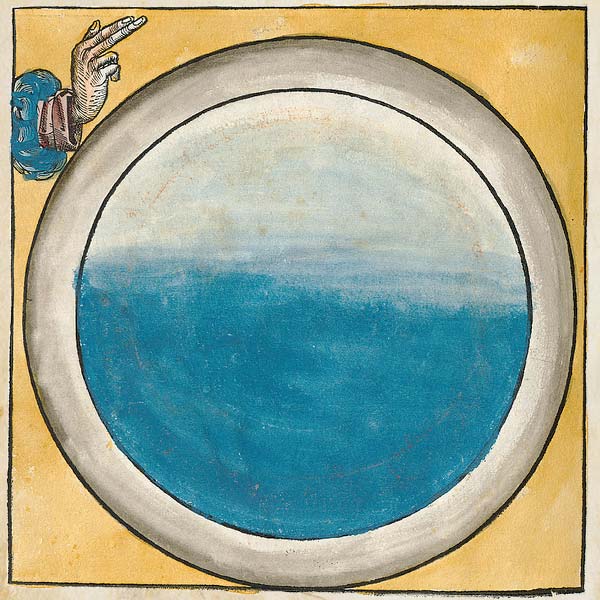
And the Lord answered Job from the whirlwind and He said:
Who is this who darkens counsel in words without knowledge?
Gird your loins like a man,
that I may ask you, and you can inform Me.
Where were you when I founded earth?
Tell, if you know understanding.
Who fixed its measures, do you know,
Or who stretched a line upon it?
In what were its sockets sunk,
or who laid its cornerstone,
when the morning stars sang together,
and all the sons of God shouted for joy?
Robert Alter, trans., The Hebrew Bible (W. W. Norton & Company, 2019), 563–564.
Second Day: Firmament
Blaise Pascal (1623–1662)
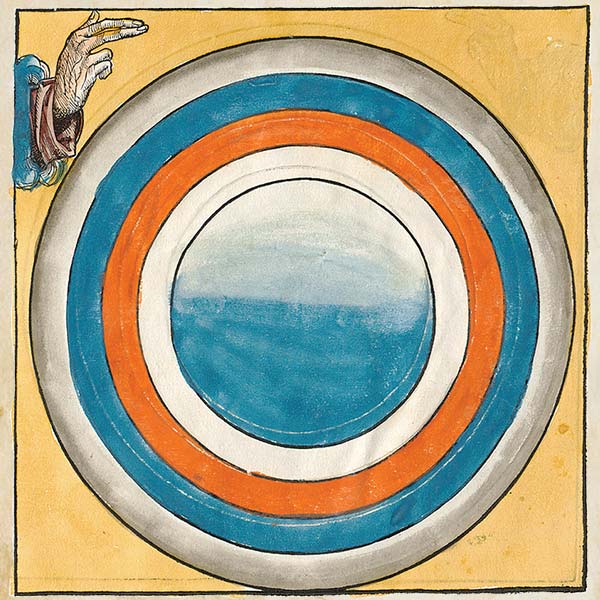
Let man then contemplate the whole of nature in her full and grand majesty, and turn his vision from the low objects which surround him. Let him gaze on that brilliant light, set like an eternal lamp to illumine the universe; let the earth appear to him a point in comparison with the vast circle described by the sun; and let him wonder at the fact that this vast circle is itself but a very fine point in comparison with that described by the stars in their revolution round the firmament. But if our view be arrested there, let our imagination pass beyond; it will sooner exhaust the power of conception than nature that of supplying material for conception. The whole visible world is only an imperceptible atom in the ample bosom of nature. No idea approaches it. We may enlarge our conceptions beyond all imaginable space; we only produce atoms in comparison with the reality of things. It is an infinite sphere, the center of which is everywhere, the circumference nowhere. In short it is the greatest sensible mark of the almighty power of God, that imagination loses itself in that thought.
Blaise Pascal, Pascal’s Pensées, trans. W. F. Trotter (E. P. Dutton, 1958), 17.
Third Day: Trees & Fruit
Julian of Norwich (1342–ca. 1416)
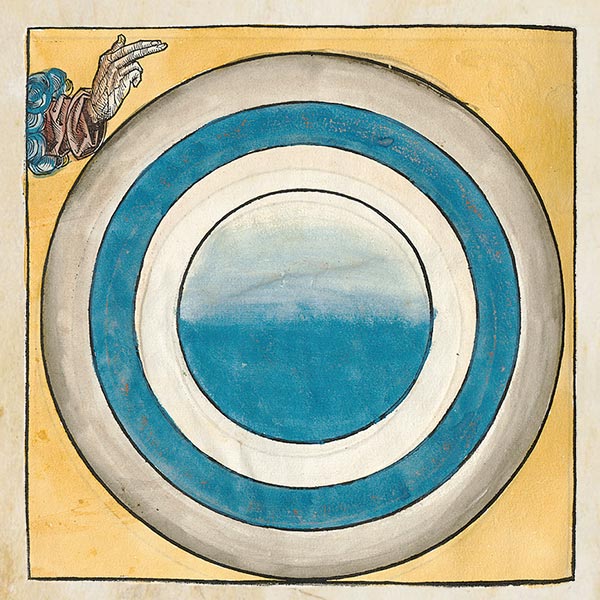
At the same time, our Lord showed me a spiritual vision of his familiar love … In this vision he also showed a little thing, the size of a hazelnut in the palm of my hand, and it was as round as a ball. I looked at it with my mind’s eye and thought, “What can this be?” And the answer came to me, “It is all that is made.” I wondered how it could last, for it was so small I thought it might suddenly have disappeared. And the answer in my mind was, “It lasts and will last for ever because God loves it; and everything exists in the same way by the love of God.” In this little thing I saw three properties: the first is that God made it, the second is that God loves it, the third is that God cares for it. But what the maker, the carer and the lover really is to me, I cannot tell; for until I become one substance with him, I can never have complete rest or true happiness; that is to say, until I am so bound to him that there is no created thing between my God and me. We need to know the littleness of all created beings and to set at nothing everything that is made in order to love and possess God who is unmade.
Julian of Norwich, Revelations of Divine Love, ed. Clifton Wolters (Penguin Books, 1966).
Fourth Day: Sun, Moon & Stars
Francis of Assisi (1181–1226)
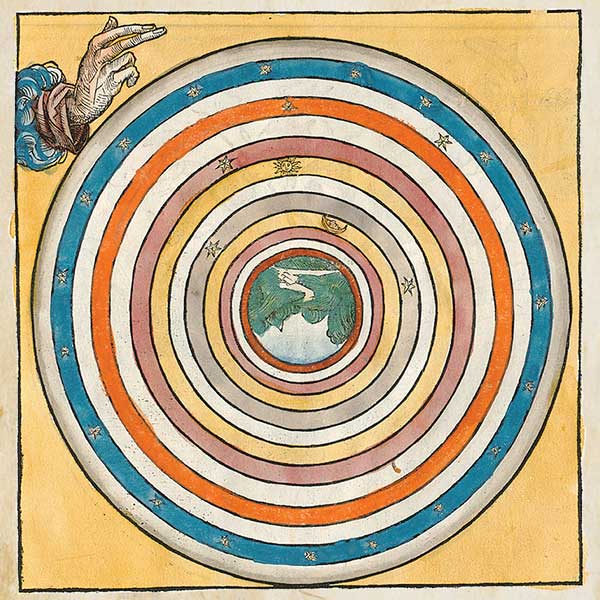
Most High, all-powerful, good Lord.
Yours are the praises, the glory, the honor, and all blessing.
To You alone, Most High, do they belong,
and no man is worthy to mention Your name.
Praised be You, my Lord, with all your creatures,
especially Sir Brother Sun,
Who is the day and through whom You give us light.
And he is beautiful and radiant with great splendor;
and bears a likeness of You, Most High One.
Praised be You, my Lord, through Sister Moon and the stars,
in heaven You formed them clear and precious and beautiful …
Praised be You, my Lord, through Sister Water,
which is very useful and humble and precious and chaste.
Praised be You, my Lord, through Brother Fire,
through whom You light the night
and he is beautiful and playful and robust and strong …
Praise and bless my Lord and give Him thanks
and serve Him with great humility.
Francis of Assisi, Francis and Clare: The Complete Works, trans. Regis J. Armstrong and Ignatius C. Brady (Paulist Press, 1982), 38–39.
Fifth Day: Birds
Mechthild of Magdeburg (ca. 1207–ca.1282)
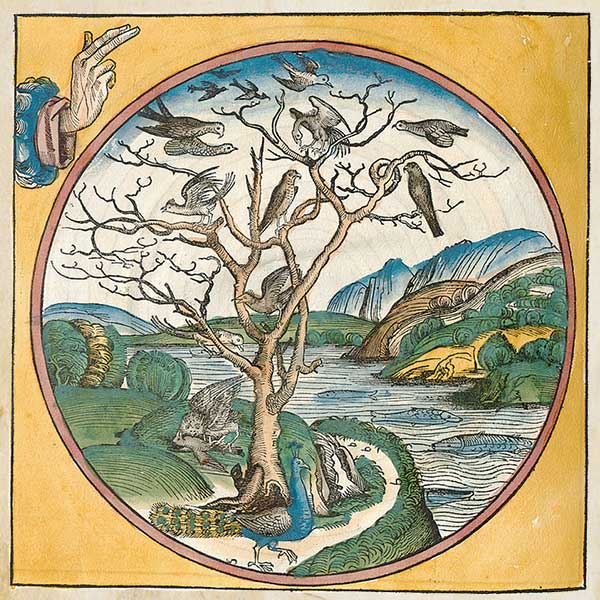
If a bird remains on the ground for a long time, its wings deteriorate and its feathers become heavy. Then it raises itself aloft beating its feathers and drawing itself far upward until it catches the air. Then it takes flight yet higher. The longer it flies, the more it soars in exhilaration, scarcely returning to earth to refresh itself. Thus did the wings of love take from it earthly pleasure. In this same way we should prepare ourselves when we are to approach God. We should raise the feathers of our longing to God. We should elevate our virtue and our good works with love. If we do not give up on this, we shall become conscious of God.
Mechthild of Magdeburg, The Flowing Light of the Godhead, trans. Frank Tobin (Paulist Press, 1998), 329.
Sixth Day: Animals
Christopher Smart (1722–1771)
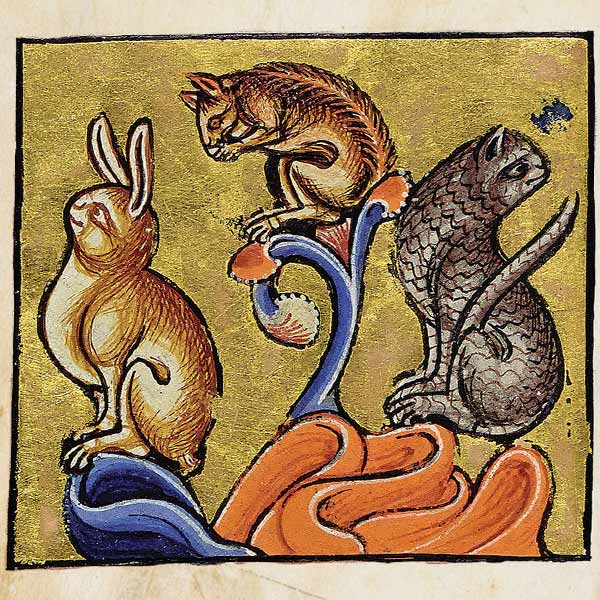
Creation of the Animals, Aberdeen Bestiary (detail) Image from Aberdeen Bestiary. Used by permission from Aberdeen University.
For I will consider my Cat Jeoffry.
For he is the servant of the Living God duly and daily serving him.
For at the first glance of the glory of God in the East he worships in his way.
For this is done by wreathing his body seven times round with elegant quickness.
For then he leaps up to catch the musk, which is the blessing of God upon his prayer.
For he rolls upon prank to work it in.…
For if he meets another cat he will kiss her in kindness.
For when he takes his prey he plays with it to give it a chance.
For one mouse in seven escapes by his dallying.
For when his day’s work is done his business more properly begins.
For he keeps the Lord’s watch in the night against the adversary.
For he counteracts the powers of darkness by his electrical skin and glaring eyes.
For he counteracts the Devil, who is death, by brisking about the life.
For in his morning orisons he loves the sun and the sun loves him.
For he is of the tribe of Tiger …
For he is a mixture of gravity and waggery.
For he knows that God is his Saviour.
Christopher Smart, Rejoice in the Lamb: A Song from Bedlam, ed. William Force Stead (J. Cape, 1939).
Sixth Day: Man
Augustine of Hippo (354–430)
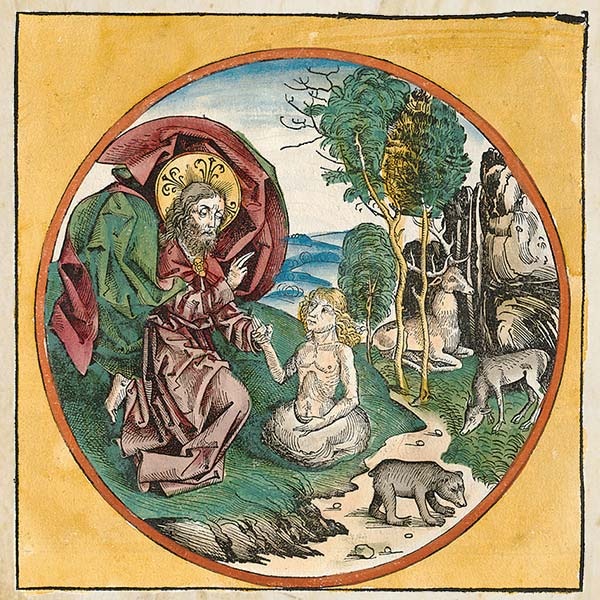
I could not therefore exist, could not exist at all, O my God, unless you were in me. Or should I not rather say, that I could not exist unless I were in you from whom are all things, by whom are all things, in whom are all things? Even so, Lord; even so. Where do I call you to, since you are in me, or whence can you come into me? For where outside heaven and earth can I go that from thence my God may come into me who has said, I fill heaven and earth?
Augustine, Confessions I.ii, trans. J. G. Pilkington, in Nicene and Post-Nicene Fathers 1:1 (1887).
Seventh Day: And It Was Good
Sadhu Sundar Singh (1889–1929)
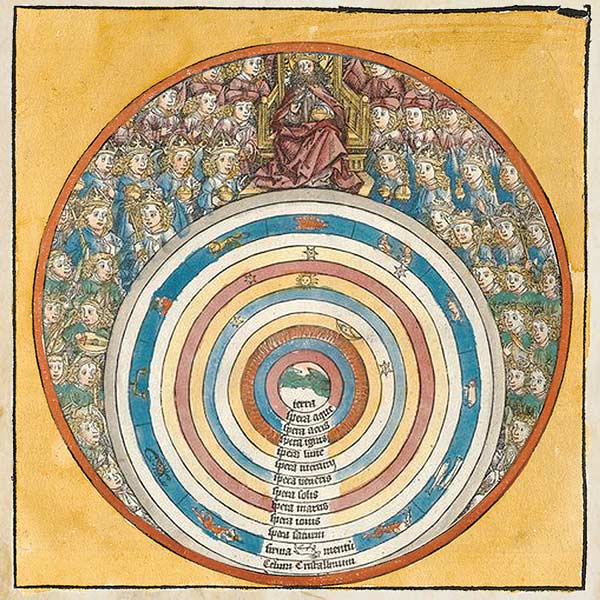
God is revealed in the book of nature for God is its author. Yet we only comprehend this book if we have the necessary spiritual insight. Without reverence and perception we go astray. We cannot judge the truthfulness of any book merely by reading it. Agnostics and skeptics, for example, find only defects instead of perfection. Skeptics ask, “If there is an almighty creator, why then are there hurricanes, earthquakes, pain, suffering, death, etc.?” This is like criticizing an unfinished building or incomplete painting. When we see them fully finished, we are embarrassed at our own folly and praise the skill of the artist. God did not shape the world into its present form in a single day, nor will it be perfected in a single day. The whole creation moves toward completion, and if we see it with the eyes of God moving toward the perfect world without fault or blemish, then we can only bow humbly before our creator and exclaim, “It is very good.”
Sadhu Sundar Singh, Wisdom of the Sadhu (Plough, 2014), 57–58.
Unless otherwise noted, the artwork accompanying these readings is taken from an account of the Creation found in the Nuremberg Chronicle, a universal history compiled by the Nuremberg doctor, humanist, and bibliophile Hartmann Schedel (1440–1514). Completed in 1493, it is one of the earliest printed books to successfully integrate illustrations and text.
Already a subscriber? Sign in
Try 3 months of unlimited access. Start your FREE TRIAL today. Cancel anytime.








































Warren Wilson
Meditations and illustrations are so thought-provoking and God-honoring. I assume that Plough has observed a diminished interest in the arts and humanities, The Smartphone is too much with us. Thanks for keeping Western Civilization alive a little longer.